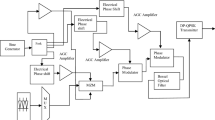Abstract
This paper shows the trade off between different modulation techniques such as multi level quadrature amplitude modulation, multi level phase shift keying, and multi level differential phase shift keying for upgrading direct detection optical orthogonal frequency division multiplexing systems with possible transmission distance up to 15,000 km and total bit rate of 2.56 Tb/s. The 2.56 Tb/s signal is generated by multiplexing 64 OFDM signals with 40 Gb/s for each OFDM. Variations of optical signal to noise ratio (OSNR), signal to noise ratio (SNR), and bit error rate (BER) are studied with the variations of transmission distance. Maximum radio frequency power spectrum, and output electrical power after decoder are measured for different multi level modulation techniques with carrier frequency. It is observed that multi level QAM has presented better performance than multi level PSK and finally multi level DPSK in optical OFDM systems. Maximum output power after decoder is enhanced with both 32-PSK, and 64-QAM. Quadrature signal amplitude level at encoder is upgraded with 64-QAM. It is noticed that OSNR, SNR, and BER are improved using 4-QAM OFDM system than either QPSK or 4-DPSK.










Similar content being viewed by others

References
Kaur, H. J., & Singh, M. L. (2013). Modelling and reporting parameters of optical OFDM system using different modulation techniques. Optics and Photonics Journal, 3, 204–210. https://doi.org/10.4236/opj.2013.32033.
Karthikeyan, R., & Prakasam, S. (2013). OFDM signal improvement using radio over fiber for wireless system. IRACST-International Journal of Computer Networks and Wireless Communications (IJCNWC), 3(3), 287–291.
Alateeq, A., & Matin, M. (2013). Study of the BER performance in RoF-OFDM system modulated by QAM and PSK”. IOSR Journal of Engineering (IOSRJEN), 3(3), 27–32.
Almasoudi, F., Alatawi, K., & Matin, M. A. (2013). Study of OFDM technique on RoF passive optical network. Optics and Photonics Journal, 3, 217–224. https://doi.org/10.4236/opj.2013.32035.
Mahros, A. M., & Tharwat, M. M. (2012). Implementation of a radio-over-fiber OFDM communication system in the simulink environment. IRACST International Journal of Advanced Computing Engineering and Application (IJACEA), 1(3), 123–128.
Wong, Y. K., Idrus, S. M., & Ghani, I. A. (2012). Performance analysis of the OFDM scheme for wireless over fiber communication link. International Journal of Computer Theory and Engineering, 4(5), 807–811.
Mahajan, S., & Kumar, N. (2012). Performance analysis of coded OFDM signal for radio over fiber transmission. IOSR Journal of Electrical and Electronics Engineering (IOSRJEEE), 1(1), 49–52.
Sethi, R. K., & Goel, A. (2015). Performance analysis of optical communication systems using OFDM by employing QPSK modulation. International Journal on Recent and Innovation Trends in Computing and Communication, 3(1), 226–237.
Singh, M., & Kaur, K. (2013). Coherent detection WDM optical OFDM system. International Journal of Advanced Research in Computer and Communication Engineering, 2(12), 4793–4797.
Bao, H., & Shieh, W. (2007). Transmission simulation of coherent optical OFDM signals in WDM systems. Optics Express, 15(8), 4410–4418.
Almasoudi, F., Alatawi, K., & Matin, M. A. (2013). 1.05 Tb/s optical-OFDM using ROF over 3600 km. Optics and Photonics Journal, 3, 318–323.
Yunazar, F. (2009). Modeling and performance analysis of the OFDM scheme for radio over fiber system. Malaysia: Master of Engineering (Electrical/Electronics and Telecommunications), Faculty of Electrical Engineering Universiti Teknologi.
Namdeo, S., & Rani, R. (2013). Designing and performance evaluation of 64 QAM OFDM System. IOSR Journal of Electronics and Communication Engineering (IOSR-JECE), 5(6), 97–105. www.iosrjournals.org.
Sanyal, S. (2015). Bit error rate performance of QPSK modulation and OFDM-QPSK with AWGN and rayleigh multipath channel. International Journal of Science and Research (IJSR), 4(7), 2086–2088.
Differential PSK (DPSK) and its performance. http://staff.ustc.edu.cn/~jingxi/Lecture%209_10.pdf.
OptiSystem Tutorials. (2014). Optical communication system design software version 13 (Vol. 1, pp. 1–500). https://dru5cjyjifvrg.cloudfront.net/wp-content/uploads/2015/03/OptiSystem_Tutorials_Volume_1.pdf.
Author information
Authors and Affiliations
Corresponding author
Additional information
Publisher’s Note
Springer Nature remains neutral with regard to jurisdictional claims in published maps and institutional affiliations.
Rights and permissions
About this article
Cite this article
Rashed, A.N.Z., Tabbour, M.S.F. The Trade Off Between Different Modulation Schemes for Maximum Long Reach High Data Transmission Capacity Optical Orthogonal Frequency Division Multiplexing (OOFDM). Wireless Pers Commun 101, 325–337 (2018). https://doi.org/10.1007/s11277-018-5690-9
Published:
Issue Date:
DOI: https://doi.org/10.1007/s11277-018-5690-9


